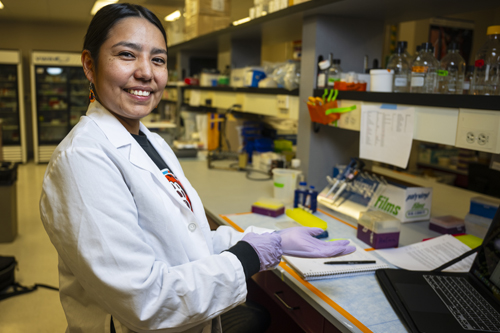Salish Kootenai College Grad Charts Ph.D. Path at UM
By Kyle Spurr, UM News Service

MISSOULA – While growing up in Arlee, Niche’ Brown remembers summers when wildfire smoke filled the Mission Valley.
Wildfire smoke is often a regular part of life in western Montana, but Brown became curious about what particles are in the smoke and how it affects human health. She took that curiosity to Salish Kootenai College in Pablo, where she earned a bachelor’s degree in life science and environmental health. Her studies included setting up an air monitoring system throughout Lake County and comparing the data to nearby counties.
Once she graduated in 2022, she decided to take a deeper dive into what happens in the body after inhaling various particles. Brown is now a graduate student pursuing her Ph.D. in the University of Montana’s toxicology graduate program, where she studies chronic inflammation of the lungs.
“I was looking at wildfire smoke in the valley,” Brown said. “I wanted to go a step further and ask, ‘How does it get into your bloodstream? How does the particle get from your lungs into your system? How do we get rid of it?’ Those questions really drove me into the toxicology program.”
Brown has focused on functionalized nanoparticles, which are microscopic particles found on common surfaces used by welders and construction workers. She is determining if the particles are toxic and if they cause inflammation in the lungs. If so, she will research if changing the material would make for a safer product.
“One of our goals is to study it more to see how we can block inflammation,” Brown said.
Andrij Holian, director of UM’s toxicology graduate program and Center for Environmental Health Sciences in the Department of Biomedical and Pharmaceutical Sciences, works with Brown as her PI (Principal Investigator) mentor. He has been impressed with Brown’s progress in her second year of the program.
“It’s taken a little bit of time, but Niche’ has really gotten a grip on this and she’s taken ownership of the project,” Holian said. “That’s when it gets exciting for me as a mentor.”
In UM’s toxicology lab, students like Brown study specific particles and how they relate to inflammation. The effects of inflammation can be found in any part of the human body and drives cancers, cardiovascular disease and neurological conditions. It’s a vast study, but the team of researchers hope to solve certain pieces and share that knowledge with the greater scientific community.
“We can’t study it all,” Holian said. “But what we try to do is look at some specific items that we breathe in that lead to lung conditions.”
Brown showed strong skills in the laboratory while at Salish Kootenai College. Her mentor during her undergraduate study contacted Holian and recommended Brown for UM’s toxicology graduate program.
Brown, whose heritage is of the Northern Arapaho Tribe in Wyoming, is the only Native American student in the UM toxicology program and would be the first to earn a Ph.D. in biomedical science.
“There’s only one in the biomedical and pharmaceutical sciences and that’s me,” Brown said.
While she’s the first, Brown hopes she’s not the last. Native Americans are underrepresented in science and Brown wants to see more give it a try.
“Culturally, we have always done science,” she said. “We have done astronomy, plant biology, engineering and pharmacology. We are really resourceful.”
Brown has considered teaching after she earns her Ph.D., and Holian agrees that would be a good fit for her. She could return to Salish Kootenai College as a professor and teach the next generation of Native students, Holian said.
“It’s a chance to really pay it forward,” he said.
Entering the Ph.D. program would have been easier if other Native students had gone before, Brown said. But while she is the only Native student in the lab, she has found comradery with her fellow students.
They share research and bounce ideas off one another all while following their passion for science. It’s a passion Brown hopes to see grow among Native people.
“I like everything about it. It’s really fun. It’s really hands-on. It’s a lot of trial and error,” she said. “I just wish more Native people would try it.”
###
Contact: Dave Kuntz, UM director of strategic communications, 406-243-5659, dave.kuntz@umontana.edu